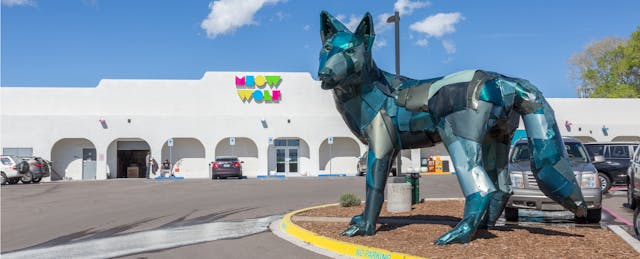Imagine yourself back in a classroom. You’re not taking English or history or pre-calculus; the sign on the door says “Obstacles.” You enter and on the board is your first assignment: create something—a drawing, a model of a house, a sketch of a new product, a sculpture. You do, and then as you step back, the teacher steps forward and smashes your creation. And tells you your next assignment is to pick up the pieces (including yourself) and make something new.
How would this course impact you? You wouldn’t be absorbing a trove of new content, but you would be learning skills critically important to thriving in our rapidly changing economies. You’d be learning to step away from perfectionism and ego-based solo creation. You’d be learning to step toward resilience, agility, designing with others, creative collaboration.
Much as I wish I’d taken a course like Obstacles, I only learned about it from Olivia Brown, an artist at Meow Wolf, an arts and entertainment company based in Santa Fe that exemplifies the new creative economy. Employing over 300 creatives, including artists, Meow Wolf is on a tear; they added 150 employees last year and they’re expanding to Denver and Las Vegas, creating immersive experiences and films and music videos, all while helping diversify the economy of New Mexico and beyond. Olivia explained how a course designed like Obstacles might prepare students to work at Meow Wolf, where her job continually requires her to let go of ego to be creatively ready for radical change.
Meow Wolf isn’t alone in looking for creatives. LinkedIn recently crunched its very large data set and concluded that the soft skill most sought by employers in 2019 is creativity. Soft skills are needed to take on the complex problems we face today, problems that largely can’t be solved by individuals working alone, but rather by teams with diverse expertise and strengths working within specific institutional contexts.

Recently, I was at Meow Wolf with five small teams of New Mexico educators—teachers, coaches, and administrators, both district and charter—who came together in Santa Fe to take on one such very large and complex problem: how to redesign school to more equitably and successfully launch students into the world that Meow Wolf represents. This is the sort of big hairy problem that demands creativity, resilience, agility and teamwork.
This work is being supported by Excellent Schools New Mexico, a local nonprofit committed to improving the quality of educational experiences for traditionally overlooked students. Excellent Schools New Mexico will fund ongoing school redesign work for these five teams, who have committed six months of their time, labor and expertise to exploring three fundamental questions:
- What are our students’ aspirations and what needs to be done to achieve them?
- Why must we reimagine school?
- How might educators, with their domain expertise, become the designers of these changes?
New Mexico has a history of being last in the nation by many traditional measures of success, such as graduation rates. All the educators at the convening felt that “lastness” deeply, and from it came an urgency to do better by their students and their state. As one educator remarked, “This is such a great state, yet so many of my peers couldn’t wait to leave. Now they have powerful jobs on the East Coast but I want to stay and build here.”
Transcend, the nonprofit I’m part of, supports school communities as they advance their conditions for innovation. For the New Mexico cohort, we designed a discovery journey that would help them take on the mindsets of creative designers. Through our collaboration, we are learning from the educator teams as much as they are learning from us.
Below are three key insights we gleaned about how to support educators to become the creatives who redesign our schools to better, more equitably serve students who need to thrive in today’s rapidly changing world.

Insight 1: Educator-designers look at problems as design issues.
They don’t blame students for failure, and they don’t blame themselves or the system either. Instead, they empathize with students and themselves—and then own the problem. They look at their teaching practices, their classrooms, their schools as malleable.
When Diana Garcia of Mark Armijo Academy listened to Olivia Brown explain Obstacles, she related immediately, “That’s just like being a teacher! We create this thing—a lesson—and the students come in and say ‘nope’ and we have to change.” Her colleague Cydelia Chavez echoed this insight. “Because the kids don’t get to stretch their creativity, they get linear in their thinking, they seize up and ask, ‘can’t I do a worksheet?’ We have to create different experiences.”
Insight 2: Educator-designers need agency.
They need to feel empowered and entrusted to define problems, design pilots and test possible solutions. They need the participation and support of school-based administrators as well as central office leaders, be they district, charter or state.
Tara Groneman, a teacher at Digital Arts & Technology Academy explained why she felt comfortable trying out a designer mindset: “We’re empowered to make our own decisions through our own agency. Agency means if there’s a problem at the school, we address it as a staff. It doesn’t just come from the administration. It comes from everybody.”
Educators also pointed out the pitfalls of the absence of agency. Another teacher mentioned how grateful she was that her school earned good enough grades in the state’s accountability system that they were left alone to explore new ideas. It’s crucial that educators have the freedom to design and redesign in a guided process.

Insight 3: We need a new type of professional learning experience that gives educator-designers the tools, processes, time and space, and networks to redesign their schools.
There is a large body of evidence, both anecdotal and research-based, on the ineffectiveness of our current model of professional development. There’s also a large body of evidence on how our schools are not serving all students in a rapidly changing world.
What if, instead of traditional PD, we borrowed a page from industry and academia, and educator learning became “learning by doing,” where teams embarked on medium- and long-term design journeys to solve problems relating to the core design of school?
Based on improvement cycles, but with a more ambitious goal, these design labs would enable educators to walk across the bridge from redesigning their classrooms to reimagining how school itself functions. As Cheryl Farrah of Atalaya Elementary remarked, “If we’re redesigning our school, we can bring creativity back.” These experiences would serve as investments in the educator workforce that pay off for students. “We get the time to brainstorm and be inspired and we come back with opportunities,” argued Josh Harrelson of Mission Achievement and Success Charter.
Over the next several months, the New Mexico teams are sure to encounter a vast array of obstacles. Through taking on a new designer mindset, they will continue to develop the resilience and creativity to keep moving their redesign work forward. And we’ll continue to learn together.


